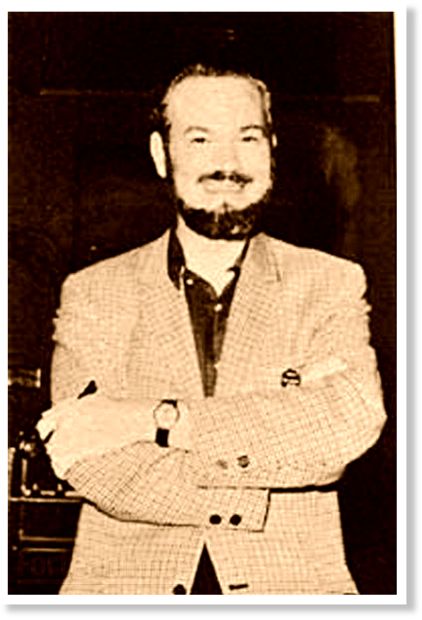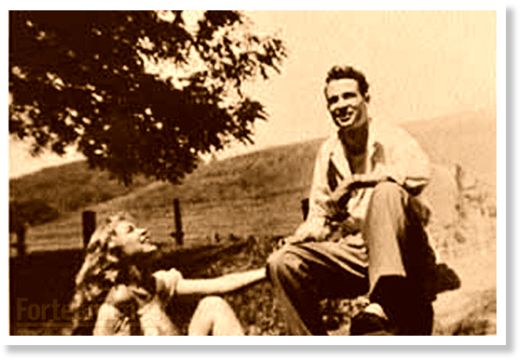
John Keel
The Mothman Prophecies
(1975) - argues Colin Bennett - stands alongside John Michell's Flying Saucer Vision
(1967), John Fowles' The Magus
(1965), Patrick Harpur's Daimonic Reality
(1994) and Anthony 'Doc' Shiels' Monstrum
(1990) as a modern masterpiece that reimagines our place in the world. Such classics point to ancient magical connections between Mind and Landscape, the antithesis of the godless 'objectivity' of a sterile materialist culture.The best writers are painters; not content merely to describe, they scorn the base instincts of cloddish objectivity and, as John Keel has done, allow themselves to become part of the investigation itself. Like the characters of Borges and Castaneda, such writers allow themselves to be fooled on occasion in order to hack into the system and let the investigation talk to them. Sometimes this risky participation mystique brings them near to death and madness, as it brought Coleridge and De Quincey and indeed Keel himself. If they survive at all, such shamanic writers bring back wonders, demonstrating that a seeker who takes no risks learns nothing.
In
The Mothman Prophecies, Keel tells an astonishing tale of how, as a budding UFO researcher in November 1966, he began investigating sightings in Point Pleasant, West Virginia, of an incredible animal form with characteristics of both man and moth. Keel found, as had his friend Ivan Sanderson before him, that the pursuit of a mystery creature - a 'cryptid' - leads very quickly to involvement with the mysteries of a landscape and a community.
Forster's Marabar caves, Hamlet's castle at Elsinore, and Thomas Hardy's Egdon Heath are all aspects of
crypto-geographic personalities; they live and breathe as huge animated forms and penetrate human awareness the way ivy weaves through an old house. These supra-human forms are quite conscious, aware, and active. In West Virginia, Keel found the local 'system-animal' had its own agenda; it 'spoke' through simulacra and weather, atmosphere and geology, coincidence and dream. Before the coming of Christianity and science, such forms as Keel describes were a fully understood part of an integrated world image that linked Mind to sacred sites, landscape, ideas and evolving culture. They were part of the knitting together of matter and idea, body and soul.
The fairies of ancient tradition did this with the kind of droll humour, grotesque mimicry and conspiratorial fooling experienced not only by Keel, but by many in the community of Point Pleasant. Our relations and dialogues with such forms of spiritual energy were destroyed when we fell first into monotheism and then again into mechanical science. The changing landscape feels and thinks, and when it is hurt it can hit back, producing forms from under the hill that disorient and confuse. They may act in defence against some kind of violation of landscape, often to a destructive purpose.
But what did Connie Carpenter see on Sunday, 27 November 1966, as she passed the deserted greens of the Mason County Golf Course outside of New Haven, West Virginia? According to Connie, it was "shaped like a man, but very much larger. It was at least seven feet tall and very broad." As its large, round, fiercely-glowing eyes fixed upon her with hypnotic effect, the grey figure unfolded a pair of wings 10ft (3m) in span. With these wings hardly moving, it then rose up in the air "like a helicopter" and swooped over her car.
Over 100 people saw this bizarre creature that winter. Point Pleasant was a town with no bars, and a population of some 6,000. Even before the sightings of Mothman and UFOs, Keel tells us of black helicopters, cattle mutilations, and 'zones of fear'. But all these things take a back seat when humanoid or semi-humanoid forms (such as Mothman) appear. The modern mind's sense of wonder, severely shackled by socially enforced scientific dialectical materialism, has hardly any models for Mothman. Stalking the humble environs of Point Pleasant are vague forms, almost-shapes from ethereal cloud worlds. If ever there was a fortean 'banned' show, it is this one.
The Mothman and his dark-clad ensemble of MIBs mumble codes and bits of strange languages as if in half-sleep. They try to drink jelly, have difficulty with knives and forks, and delight in leaving messages that utterly confuse the UFO witnesses and so-called contactees. They arrive at the homes of witnesses in black saloon cars with untraceable license plates, wearing authentic USAF uniforms, and tell them not to listen to John Keel, should he ever call and ask questions about Mothman... or anything else, for that matter. Some make vague threats to these witnesses, but only as a kind of automated after-thought. Others smell bad, their clothes hang on their very bones, and they wheeze and cough as if seriously ill. Their language and sentence-structure appear to be curiously manufactured, as if by some faulty machine. Their time references are seriously out of date, and all common social and personal sense is fractured in some peculiar way.
As if this were not enough, the phenomenon followed Keel around. After he returned to Manhattan, some 800 miles (1300 km) from Point Pleasant, the figures that continued to manifest appeared to be part of a linked group, and were intensely agitated by Keel's investigations. It was almost as if his inquiries played a part in bringing them into being. The deeper he dug, the worse the situation became. And of course the telephone system - a classic icon of paranoia - starts talking to itself, selectively ringing and connecting parties in the investigational loop. The postal service becomes equally moody. Like the entities themselves, it is not so much threatening as appearing to undergo the mood changes of a small child.
As word of his investigations spread, Keel becomes a
foco novo for UFO 'contactees'. They lurch towards him in concert, like the zombies in
Night of the Living Dead. They find him, wherever he is, and they contact him by all possible means. Most claim that they have a personal message from the UFO occupants for Keel himself. As a result, poor Keel finds himself mentally in the middle of a maze of smashed telephone junctions and early soap and science fiction plots. He does not meet any of the entities directly; the UFO contactees become his listening posts and they relay what the entities have said. Some hear the entities speaking in their minds, and the accuracy of the information given in this manner is often chilling.
Contactee Howard Menger & friend
Contactee Howard Menger and friend
Keel has three different systems. He passes questions to the contactees; they relay them to the entities and give Keel the replies. Though Keel makes the questions as complicated as he can, there are quick and correct answers. He posts letters to addresses he knows do not exist, yet gets answers (in block capitals) the very next day. Lastly, he speaks directly to the entities by phone, and the voices on the other end sound to him like those which speak through a medium at a séance.
A single theme unites the vast confusions of the contactees. It is the warning that humanity is about to go through a most profound change involving a new form of control or reprogramming. At that time, 1966, personal computers were almost 20 years in the future, yet it seems as if Keel entered an Internet-like gaming world of many dimensions resembling, perhaps, the classic 1960s British TV series
The Prisoner. The contactee world echoes his most private thoughts and throws back answers, conclusions, recommendations and not a few jokes.
As a high-tech party trick, this phenomenon could be totally personalised with spectacular physical effects; for instance, Keel picks a motel at random to find mail waiting for him there. If George Adamski and Howard Menger had contacted such a wrecked ship of mad fools and cadaverous actors as Keel describes, they might well have been victims of similar confusions some 15 years before Keel experienced them. But the clever and analytic Keel - perhaps sharper than Adamski and Menger (above, bless them!) - noted "that as soon as my attitude towards a game changed, the entities switched to a new game".
As Keel describes it, the whole State of Ohio suffered what can only be described as an invasion of 'dolls'. Just one of the curious things about these figures is that, more than anything else, they remind us of the Media. Keel's living cartoons scream, gurgle, and generally camp it up, as if a laboratory full of half-completed media 'personalities' had been freed by some doll-liberation society. As human imitations, his communicating entities - Indrid Cold, Klinell, Mr Apol, and Lia - are bland, floppy and androgynous, more comic than sinister. Seen as figures in a late-1960s prophetic Media allegory, Keel's grotesques are like early Michael Jackson seedlings, stalking the borderland between the 'factual' Point Pleasant and the 'fictional' Twin Peaks.
Point Pleasant or Twin Peaks?
Point Pleasant
Keel's book was indeed prophetic;
the new 'control system' emerged as Mass Media, which is essentially a 'doll culture'. Our media 'personalities' behave much like those observed entities. More than 30 years later, we now know what Keel's idea of 'reprogramming' really aimed to do... to destroy the OFF switch. We are all Americans now, whether we like it or not.
Alien 'invasion' may, in fact, have taken just such a subtle form, its flying discs mere props from some abandoned rehearsal. In this, popular culture has proved itself to be a more complex thing than mere peasant-control. It is an entire universe full of very complex communications, far more significant and powerful than pre-industrial 'fact'; the 'product' is a state of mind, not an industrial artefact. Perhaps after all, the 'trip' experiences of the 1960s taught us one important thing: that time itself is linked essentially to change of metaphor.
If the entities we meet in
The Mothman Prophecies are 'built' of anything it is metaphorical suggestion-concentrate - Media plasma. This means that 'contact' is much more likely to resemble a software gaming experience than anything to do with the equations of the Industrial Revolution. Since human consciousness is built of advertisements, we should not be surprised that the virtual event - such as the Y2K concern, the Gulf War and the hunt for Osama Bin Laden - has come to dominate. An advanced alien culture may have abandoned our crude concepts of industrial solidity altogether in favour of slivers of powerful suggestion-stuff with 'performance' replacing crude 'reality'. But of one thing we can be sure - consciousness of any kind will contain elements of corruption and madness, failure and despair, and perhaps even love and inspiration.
But if - as
The Mothman Prophecies implies - the spirits of hill and dale are laughing at us, it would make for a much more interesting and fruitful interaction between Humanity and Nature than that of the simple-minded Real versus Unreal. It would also be a refreshing change from the Holy, Sober, and Profound Christian view. To put Keel's experience in the very best of Classical perspectives, we might have to return to the ancient Greek view that the truth is scandalous beyond all belief, and the gods are neither respectable nor sensible entities at all.
Of course, those afflicted with the 'real' will want to know whether
The Mothman Prophecies is fact or fiction. Composed over 30 years ago, it was prophetic in its suggestion that the then prevailing model of Mind - as a hard-wired Pavlovian/behaviourist 'information processing' machine (relying on a far too easy separation of facts and fictions) - was doomed. Keel himself suggests that the software of image and advertisement is a much better model for the thinking process, and that related mental activity is more like a fuzzy negotiation between hallucinations than a 'factual' process in the old industrial sense.
In his later
Disneyland of the Gods (1988) Keel, looking back on
The Mothman Prophecies, suggests that mental operations are organised by the metaphor of entertainment rather than any structure of factual logic. Certainly the major assassinations of our time were more about show business than old-fashioned politics. Like Keel's grotesques, all the killers were show-dolls of a kind, each one a Pandora's box of living conspiracies, just as was every single one of the victims, from John Kennedy to Princess Diana.
In the Web-world of the burgeoning 21st century, it is possible that such ephemera and such semi-realisations will unleash treachery, revenge, murder, and destruction just as did the old economies, politics, structures of decayed science, and vanished national identities. Even chronic English scepticism - like the science it supports - is now part of the entertainment industry. Most sceptical claims are counter-hoaxes, different aspects of the same fortean joke that made Keel's Point Pleasant the factual version of the later fictional TV series
Twin Peaks. In a fortean world, fact and fiction are versions of one another. In every British city and town there are alchemical temples manned by celibate witch doctors; this organization is called the Catholic Church and, as Jung reminds us, the Mass is an alchemical ceremony with roots deep in ancient occultism. Brought up to date, a change of paradigm means a change of media. In this sense, the patently incomplete nature of Keel's aliens means that they are neither real nor unreal so much as being 'under construction'.
In the fortean sense, scientific objectivity has 'banned' our recognition of any participants in our conscious life other than fellow humans. Shakespeare shows that there are unnamed
dramatis personae implicit in the human situation, showing that humans are not lords of creation but part of an evolving chain of being, shading from 'solid' to almost nothing. This chain consists of animal, vegetable and mineral domains, all of which have dynamic anthropomorphic elements that we ignore at our peril. Like Shakespeare's
The Tempest,
The Mothman Prophecies depicts humans as poised between the animal kingdoms and the realms of the gods. When the transport to and from Middle-Earth breaks down, many domains above and below hit back, throwing off man-made structures. In this sense, Hardy's Egdon Heath is as much responsible for the death of Eustacia Vye as Keel's mysterious beings are for the collapse of the bridge at Point Pleasant and the deaths of 38 people. The Greek Tragedians understood completely such connections between environment and social character, motivation and supra-human agendas. Meantime, fallen moderns grate their teeth on the mechanical, and wonder that they cannot explain events in Dallas 1963, the assassination of Princess Diana, or the murder of little Jon Bennet.
Back in New York for Christmas 1966, the horns of Elfland still sounding in his head (as they did for Coleridge and Blake), Keel, too, is nearly done for. Like many who return from the magic landscape of Magonia, Keel, as wounded initiate, is sick and exhausted. Occult initiation is always a near-death experience. When he hears the news of the collapse of the Point Pleasant bridge on TV, he knows that his West Virginian wounds will be there for a lifetime, reminders of time present and time past, arrival and departure. Finally, John Keel decided that human beings do not solve mysteries so much as decide which set of answers they can most comfortably live with. In showing how he reached this decision, he created a true 20th-century sonata form in
The Mothman Prophecies.
This is just a pleasure to read. Much to absorb; wise; and done with a twinkle in the eye.